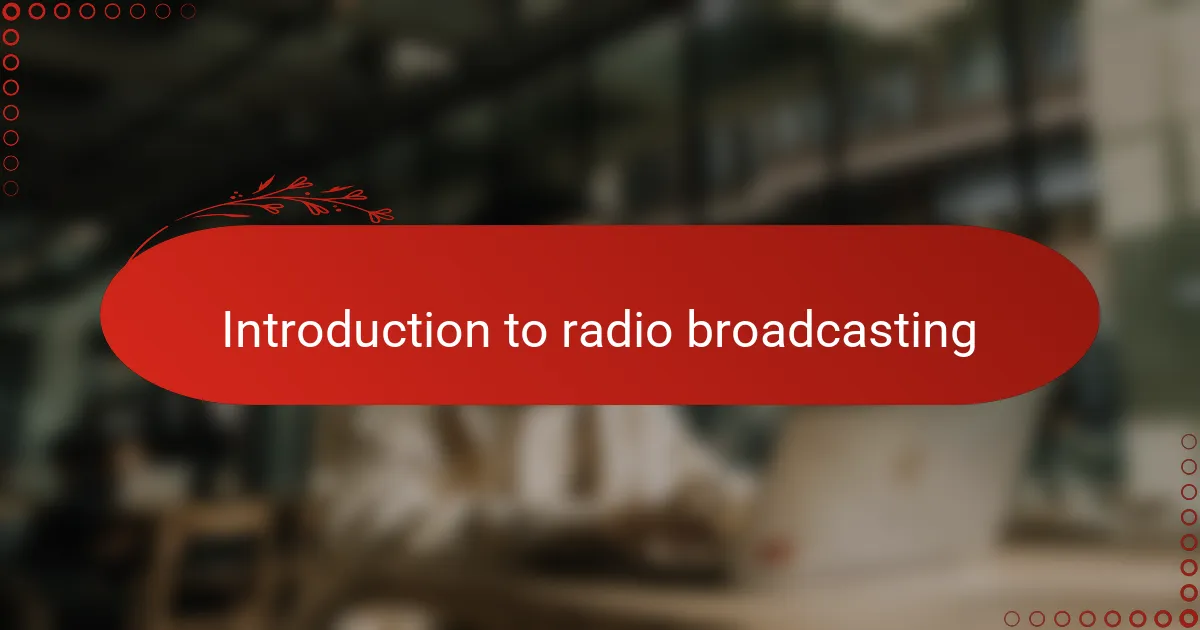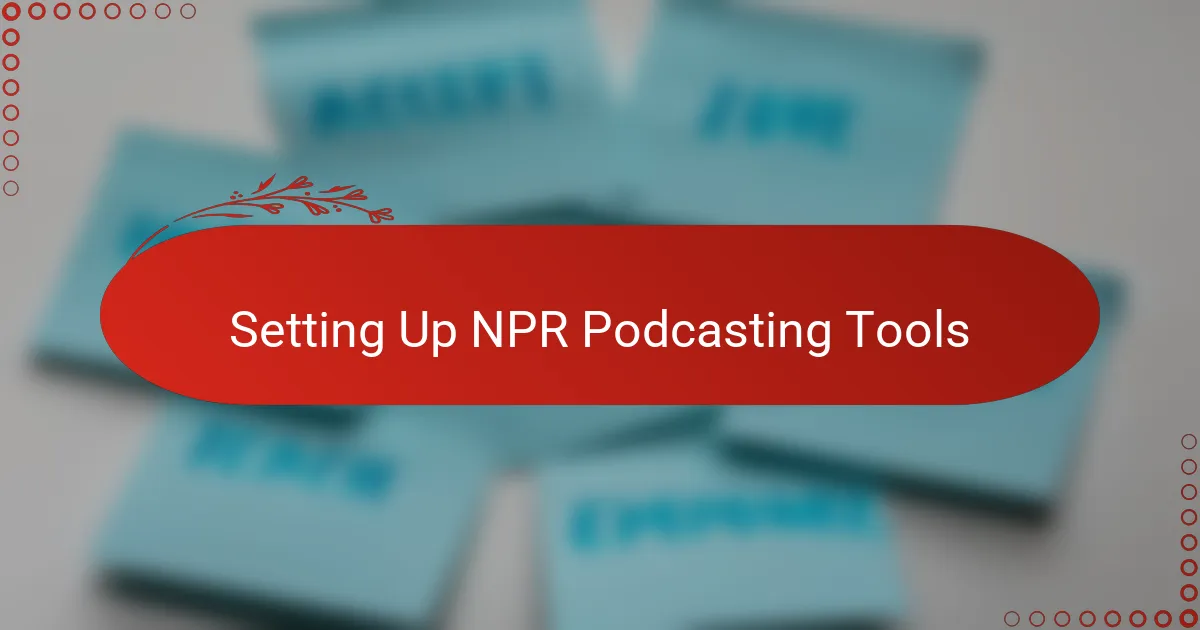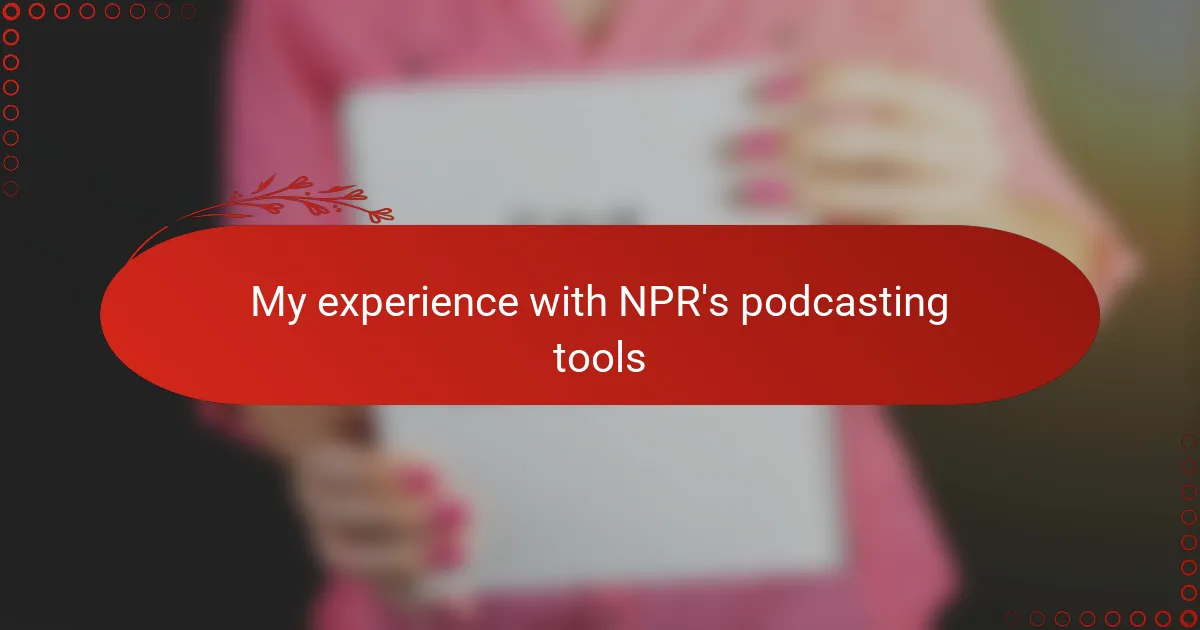Key takeaways
- Radio broadcasting creates a unique intimacy through sound, fostering community and connection in real time.
- NPR’s podcasting tools combine user-friendly design with professional quality, making podcast creation accessible for all levels.
- Integrated features like metadata tagging and seamless publishing enhance discoverability and streamline distribution processes.
- Built-in tutorials and support empower users, boosting confidence and encouraging creativity throughout the production journey.

Introduction to Radio Broadcasting
Radio broadcasting has always fascinated me because it blends storytelling with technology to reach people in real time. I remember the first time I tuned into a local station and felt instantly connected to voices miles away, sharing stories, music, and news as if they were right beside me. Have you ever wondered how those voices manage to create such a vivid, personal experience solely through sound?
What intrigues me most about radio is its simplicity and immediacy—just a microphone, a transmitter, and a message traveling through the airwaves to listeners everywhere. This raw, direct connection creates a unique intimacy that podcasts and other digital formats try to mimic but can never quite replicate. It makes me appreciate every little detail involved in producing a broadcast, from scripting to sound editing.
In my years working with radio and its digital offshoots, I’ve come to see broadcasting not just as a medium but as a powerful way to build community and share ideas instantly. This immediacy and sense of connection are what continue to draw me to explore the tools and techniques behind bringing those voices to life.

Overview of NPR Podcasting Tools
NPR’s podcasting tools impressed me right away with their blend of professional quality and user-friendly features. I found their platform thoughtfully designed to accommodate both seasoned producers and newcomers, which made diving into podcast creation less intimidating. Have you ever wished for tools that feel like they understand your creative flow rather than interrupt it? That’s exactly how NPR’s tools felt to me.
One feature I particularly appreciated was how NPR’s software integrates sound editing, metadata tagging, and publishing all in one place. This seamless approach saved me a lot of time and frustration I’ve experienced juggling multiple programs. It felt like having a reliable co-producer quietly handling technical details while I focused on storytelling.
What stood out most was the attention NPR pays to accessibility and audience engagement tools. From embedding interactive episode notes to easy distribution channels, it’s clear they designed these tools to help podcasters connect deeper with their listeners. In my experience, when technology supports genuine connection, the content shines brighter — and NPR gets that perfectly.

Key Features of NPR Podcasting Tools
One of the key features that struck me about NPR’s podcasting tools is their intuitive sound editing interface. It’s so well thought out that I often found myself tweaking audio levels and layering sounds without the usual headache of complicated controls. Have you ever had software that just seemed to anticipate your next move? That’s exactly the kind of ease NPR delivers.
Another feature I really value is the integrated metadata tagging system. At first, I didn’t realize how crucial proper tagging was for discoverability and organization until I saw how quickly my episodes gained traction. NPR’s tools make it straightforward to add detailed descriptions and keywords, which honestly felt like giving my podcast a better chance to stand out in a crowded space.
I also can’t forget to mention the publishing capabilities that streamline distribution across platforms. It saved me from the hassle of manually uploading files everywhere, which used to be a tedious chore. With NPR’s tools, I focused more on content creation and less on the technical shuffle—something any podcaster can appreciate, especially when deadlines loom.

Setting Up NPR Podcasting Tools
Getting started with NPR’s podcasting tools was surprisingly straightforward, which caught me off guard in the best way possible. I remember setting up my first episode and feeling a sense of relief as each step was clearly guided without overwhelming technical jargon. Have you ever faced that panic of not knowing where to begin only to find the process gently laid out for you? That’s exactly what NPR’s setup felt like.
I also appreciated how quickly I could connect my existing audio equipment without a hitch. The tool’s ability to recognize different input devices made me wonder why more platforms don’t make that easier. It’s a small detail, but for me, it meant fewer headaches and more time focusing on the creative side of producing.
What really sealed the deal was the built-in tutorials and support throughout the setup. They didn’t just toss me into the deep end; instead, I felt supported every step of the way, which boosted my confidence tremendously. If you ask me, that’s the kind of thoughtful design that turns a hesitant beginner into a motivated podcaster in no time.

Using NPR Tools for Podcast Production
Using NPR’s podcast production tools felt like having a trusted partner by my side. One moment I was wrestling with complex audio layering, and the next, I found myself intuitively navigating their clean interface without second-guessing each move. Have you ever experienced software that just seems to get your creative rhythm? That’s exactly how NPR’s tools worked for me, smoothing out the technical bumps so my storytelling could flow naturally.
What really struck me was how NPR combines technical precision with creative flexibility. Their editing suite not only lets me balance sound levels effortlessly but also gives me the freedom to experiment with different effects without fear of messing up. It reminded me of working in a professional studio, minus the intimidation—this balance is something I had always sought but rarely found in one platform.
I also appreciated how NPR’s production tools handle the nitty-gritty tasks behind the scenes, like embedding show notes and preparing files for distribution. It feels like a weight lifted off my shoulders when I don’t have to juggle multiple apps or worry about formatting. Have you noticed how much time you save when tech just works quietly in the background? For me, that’s when the real magic of podcasting begins.

Personal Experience with NPR Tools
Working with NPR’s podcasting tools has been a game-changer for me. I distinctly remember the first time I uploaded an episode and how smooth the entire process felt—I didn’t wrestle with confusing menus or cryptic error messages like I had with other platforms. Have you ever felt that relief when tech actually just works the way you expect it to? That moment made me realize how much a well-designed tool can boost creativity and reduce frustration.
One thing that really resonated with me was how NPR’s tools seemed to anticipate my needs. For instance, when tweaking audio levels, I often found myself focused purely on storytelling, barely noticing the edits happening behind the scenes. It felt like having a skilled assistant who understands your rhythm and workflow, which took a lot of pressure off during tight deadlines.
I also appreciated the sense of support embedded throughout the user experience. When doubts crept in—like how to optimize metadata or handle distribution—the clear guides and helpful prompts felt like a friend patiently guiding me through each step. That kind of thoughtful design made me confident to experiment, knowing I wasn’t alone in navigating the technical side. Have you ever wished for a tool that felt genuinely supportive rather than just functional? NPR’s podcasting tools gave me exactly that.

Tips for Maximizing NPR Podcasting Tools
When diving into NPR’s podcasting tools, I found that embracing their metadata features early on made a world of difference. Have you noticed how proper tagging can transform your podcast’s reach? Adding clear, descriptive tags felt like planting signposts that helped new listeners find my episodes effortlessly.
Another tip I’d share is to fully leverage the integrated publishing system. It saved me countless hours by automating distribution across platforms, which meant I spent more time honing my stories and less time wrestling with uploads. Isn’t it amazing how a little automation can lighten the workload and spark creativity?
Finally, don’t overlook the built-in tutorials and support resources. In moments when I felt stuck or overwhelmed, turning to these guides felt like having a mentor beside me, gently steering me back on track. Have you ever experienced that reassuring nudge from a tool that cares about your success? That’s exactly the vibe NPR’s tools give off, making the whole process not just doable, but genuinely enjoyable.
